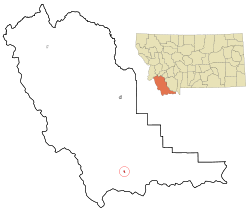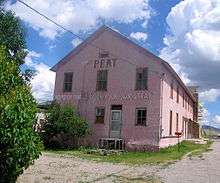Lima, Montana
Lima (/ˈlaɪmə/, LY-mə) is a town in Beaverhead County, Montana, United States. The population was 221 at the 2010 census.
Lima, Montana | |
|---|---|
 The historic business district of Lima, Montana, Summer 2010. | |
 Location of Lima, Montana | |
| Coordinates: 44°38′9″N 112°35′31″W | |
| Country | United States |
| State | Montana |
| County | Beaverhead |
| Area | |
| • Total | 0.55 sq mi (1.42 km2) |
| • Land | 0.55 sq mi (1.42 km2) |
| • Water | 0.00 sq mi (0.00 km2) |
| Elevation | 6,257 ft (1,907 m) |
| Population | |
| • Total | 221 |
| • Estimate (2019)[3] | 227 |
| • Density | 414.23/sq mi (159.84/km2) |
| Time zone | UTC-7 (Mountain (MST)) |
| • Summer (DST) | UTC-6 (MDT) |
| ZIP code | 59739 |
| Area code(s) | 406 |
| FIPS code | 30-43525 |
| GNIS feature ID | 0773340 |
The community was named after Lima, Ohio, the native home of an early settler.[4]
Geography
Lima is located at 44°38′9″N 112°35′31″W (44.635813, -112.592058).[5]
According to the United States Census Bureau, the town has a total area of 0.53 square miles (1.37 km2), all of it land.[6]
Climate
According to the Köppen Climate Classification system, Lima has a semi-arid climate, abbreviated "BSk" on climate maps.[7]
Demographics
| Historical population | |||
|---|---|---|---|
| Census | Pop. | %± | |
| 1920 | 476 | — | |
| 1930 | 459 | −3.6% | |
| 1940 | 554 | 20.7% | |
| 1950 | 483 | −12.8% | |
| 1960 | 397 | −17.8% | |
| 1970 | 351 | −11.6% | |
| 1980 | 272 | −22.5% | |
| 1990 | 265 | −2.6% | |
| 2000 | 242 | −8.7% | |
| 2010 | 221 | −8.7% | |
| Est. 2019 | 227 | [3] | 2.7% |
| U.S. Decennial Census[8][9] | |||
2010 census
As of the census[2] of 2010, there were 221 people, 106 households, and 63 families residing in the town. The population density was 417.0 inhabitants per square mile (161.0/km2). There were 173 housing units at an average density of 326.4 per square mile (126.0/km2). The racial makeup of the town was 94.1% White, 0.9% African American, 0.9% Native American, 0.9% Pacific Islander, 0.5% from other races, and 2.7% from two or more races. Hispanic or Latino of any race were 3.6% of the population.
There were 106 households, of which 23.6% had children under the age of 18 living with them, 49.1% were married couples living together, 6.6% had a female householder with no husband present, 3.8% had a male householder with no wife present, and 40.6% were non-families. 38.7% of all households were made up of individuals, and 11.3% had someone living alone who was 65 years of age or older. The average household size was 2.08 and the average family size was 2.75.
The median age in the town was 51.8 years. 23.5% of residents were under the age of 18; 2.8% were between the ages of 18 and 24; 13.7% were from 25 to 44; 34.8% were from 45 to 64; and 25.3% were 65 years of age or older. The gender makeup of the town was 52.9% male and 47.1% female.
2000 census
As of the census[10] of 2000, there were 242 people, 109 households, and 64 families residing in the town. The population density was 438.7 people per square mile (169.9/km2). There were 158 housing units at an average density of 286.4 per square mile (110.9/km2). The racial makeup of the town was 92.98% White, 2.89% Native American, 1.65% from other races, and 2.48% from two or more races. Hispanic or Latino of any race were 1.65% of the population.
There were 109 households, out of which 22.9% had children under the age of 18 living with them, 53.2% were married couples living together, 3.7% had a female householder with no husband present, and 40.4% were non-families. 34.9% of all households were made up of individuals, and 13.8% had someone living alone who was 65 years of age or older. The average household size was 2.22 and the average family size was 2.94.
In the town, the population was spread out, with 25.6% under the age of 18, 2.5% from 18 to 24, 24.8% from 25 to 44, 24.4% from 45 to 64, and 22.7% who were 65 years of age or older. The median age was 44 years. For every 100 females there were 103.4 males. For every 100 females age 18 and over, there were 93.5 males.
The median income for a household in the town was $20,313, and the median income for a family was $28,438. Males had a median income of $22,083 versus $17,500 for females. The per capita income for the town was $13,163. About 20.6% of families and 26.8% of the population were below the poverty line, including 47.4% of those under the age of eighteen and 11.9% of those 65 or over.
Arts and culture

The town is also a magnet for Continental Divide hikers and bikers, in part because of the hospitality of a local motel owner, who is also a ‘trail angel’. As such, he is willing to shuttle hikers from and to Monida Pass where the Continental Divide Trail crosses Interstate 15. The town boasts a restaurant where patrons can cook their own steak and a convenience store where hikers can re-supply.
References
- "2019 U.S. Gazetteer Files". United States Census Bureau. Retrieved July 26, 2020.
- "U.S. Census website". United States Census Bureau. Retrieved 2012-12-18.
- "Population and Housing Unit Estimates". United States Census Bureau. May 24, 2020. Retrieved May 27, 2020.
- Moyer, Armond; Moyer, Winifred (1958). The origins of unusual place-names. Keystone Pub. Associates. p. 75.
- "US Gazetteer files: 2010, 2000, and 1990". United States Census Bureau. 2011-02-12. Retrieved 2011-04-23.
- "US Gazetteer files 2010". United States Census Bureau. Archived from the original on 2012-01-25. Retrieved 2012-12-18.
- Climate Summary for Lima, Montana
- "Census of Population and Housing". Census.gov. Retrieved June 4, 2015.
- "Census & Economic Information Center". Retrieved July 3, 2015.
- "U.S. Census website". United States Census Bureau. Retrieved 2008-01-31.
